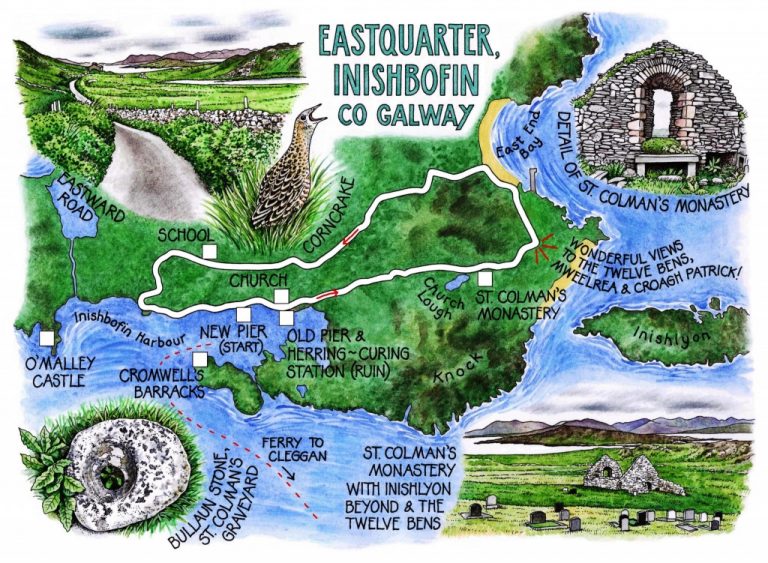Irish Independent – WALK OF THE WEEK – Christopher Somerville
25 June 2011
101. Eastquarter, Inishbofin, Co Galway

It had been another of those dreamy island days when time runs as thick and slow as honey. Inishbofin lay under the spell of very typical evening weather – heavy cloud cover and a warm, gentle breeze. We’d spent the morning wandering through the west end of the island, the afternoon idling around the harbour watching the ferries and fishing boats come and go. There might be music later in the Doonmore Hotel. There certainly would be fish, chips and a few nice pints. But what about now? How to spend the early evening, now that the last ferry had departed for the world beyond the harbour mouth?
Island roads are social creatures. If you step out just past cup-of-tea-o’clock, you’re bound to be met and gret. A very senior citizen, wearing a traditional islandman’s tam-o’-shanter in chequered tweed, nodded to us from his front door where he was leaning slantwise, one jamb to the other. ‘Enjoying our little lovely island?’ ‘We certainly are!’ ‘And you’re very welcome. If you go along that way,’ – he indicated the eastern-heading road – ‘you’ll meet yourself coming back in a pleasant hour or two.’ That was such a nice way of putting it that we set out forthwith.
The Galway islands wear their histories in full view. Down by the old pier tottered the ruin of a herring-curing station, one of the hundreds of projects set up in Connemara by the Congested Districts Board in the hard times around the turn of the 20th century. Out beyond it, Cromwell’s Barracks clung to its rocky perch at the eastern tip of Inishbofin Harbour. Cromwell’s men constructed the star-shaped fort there in 1656-7 on the site of a previous stronghold built by one Don Bosco, a Spanish buccaneer and friend of the O’Malley’s of Inishbofin. In those wild days a mighty chain would be stretched nightly across the mouth of the inlet between Don Bosco’s fort and Granuaille’s block-like castle opposite, a disincentive to would-be strangers. The wheel of history has turned, and nowadays the stranger feels like a friend here.
Edged with pyramidal orchids and pink windmills of ragged robin, the road curved and led us inland. Up behind the spiky whaleback of Knock hill, Church Lough lay low and reed-fringed under a spatter of yellow water lilies. From the road summit we looked out across Inishlyon and the broad sound of Ballynakill to the westernmost shores of Connemara and the distant hummocks of the Twelve Bens, their peaks cut hard and definite against the low motionless clouds. The drift of the shadows brushed their flanks with purple; every sun shaft dressed them in pale green. Mweelrea was a solid lump in the east, and twenty miles away bare-shouldered Croagh Patrick stood with its pointed head in the clouds.
You need something special to pull you away from a view like that, and it was the corncrakes that supplied it. Inishbofin is one of the very few places in Ireland to have retained a population of these secretive ground-nesting birds. Corncrakes need long grass to nest and bring up their youngsters in concealment, and modern intensive farming with its insistence on cutting grass short, early and often has pretty well done for them. But here on the island, patches of grass are deliberately left long to encourage the corncrakes.
‘Crex! Cre-e-e-x!’ rang out from the overgrown graveyard of St Colman’s monastery just down the road. If corncrakes went in for the X-factor they’d have been sneered out of the room long since. But that grating call is a conservationist’s aria. Down in the beautiful little stone church and out among the ancient cross-slabs and bullauns of the graveyard we rejoiced over its harsh, triumphant rasp.
Buttercups, clovers, yellow rattle, marsh orchid; a rich carpet of wild flowers to beautify our evening walk. We turned north along East End Bay, past the old fishermen’s cottages and on up the perfect fingernail of creamy sand, shoes in hand. Time enough to meet ourselves coming back. Just now, scuffing the heavy sand like silk between our toes, we were content to see absolutely no-one else.
WAY TO GO
MAP: OS of Ireland 1:50,000 Discovery 37
GPS: satmap.com
TRAVEL:
Bus (www.michaelneecoaches.com; www.citylink.ie): Galway-Cleggan
Road: Cleggan is signed from N59 between Letterfrack and Clifden
Ferries: Island Discovery (095-45819/45894; www.inishbofinislanddiscovery.com), King Ferries (095-44649) from Cleggan to Inishbofin
WALK DIRECTIONS: From the pier turn right along the island road. Bear left uphill by the church and follow this lower road out to pass St Colman’s Abbey. At East End Bay, a ‘pier’ sign points you back along the upper road. Keep along it past the school to descend to the coast road; left to the pier.
LENGTH: 4 miles (6.5 km): allow 2 hours
GRADE: Easy
CONDITIONS: Tarmac roads all the way. Buggy-friendly throughout.
DON’T MISS … !
• fantastic views all round, especially south-east to 12 Bens
• St Colman’s Abbey
• corncrakes – keep your ears peeled
REFRESHMENTS/ACCOMMODATION: Doonmore Hotel (095-45814/04; www.doonmorehotel.com); Day’s Hotel (095-45809; www.dayshotel.ie); Dolphin Hotel & Restaurant (095-45991; www.dolphinhotel.ie); Galley B&B and Restaurant (095-45894); Lapwing House (095-45996)
GUIDE BOOKS/LEAFLETS: Map-guide widely available on Inishbofin
OPERATOR: Connemara Safari Walking Holidays (Gerry McCloskey: 095-21071 or Freephone 1850 777 200; www.walkingconnemara.com)
WALKING in IRELAND: Walking tour operators, local walks including Discover Ireland’s National Loop Walks, walking festivals throughout Ireland: www.discoverireland.ie/walking.
BOOK: Christopher’s book Walking in Ireland (Ebury Press) contains 50 of his favourite Irish Independent walks.
INFORMATION: www.inishbofin.com
csomerville@independent.ie